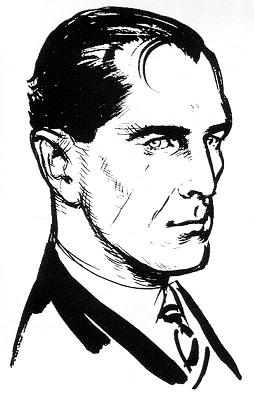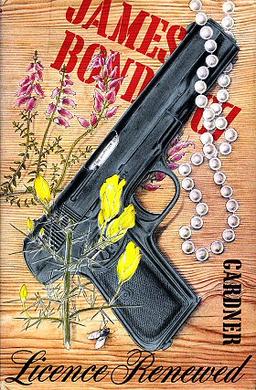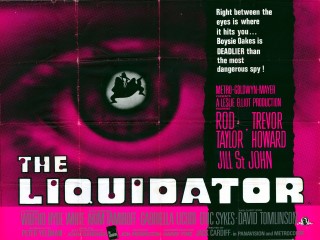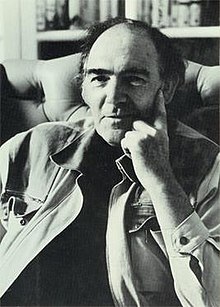
The James Bond series focuses on the titular character, a fictional British Secret Service agent created in 1953 by writer Ian Fleming, who featured him in twelve novels and two short-story collections. Since Fleming's death in 1964, eight other authors have written authorised Bond novels or novelisations: Kingsley Amis, Christopher Wood, John Gardner, Raymond Benson, Sebastian Faulks, Jeffery Deaver, William Boyd, and Anthony Horowitz. The latest novel is With a Mind to Kill by Anthony Horowitz, published in May 2022. Additionally Charlie Higson wrote a series on a young James Bond, and Kate Westbrook wrote three novels based on the diaries of a recurring series character, Moneypenny.

Dr. No is the sixth novel by the English author Ian Fleming to feature his British Secret Service agent James Bond. Fleming wrote the novel in early 1957 at his Goldeneye estate in Jamaica. It was first published in the United Kingdom by Jonathan Cape on 31 March 1958. The novel centres on Bond's investigation into the disappearance in Jamaica of two fellow MI6 operatives. He establishes that they had been investigating Doctor No, a Chinese operator of a guano mine on the fictional Caribbean island of Crab Key. Bond travels to the island and meets Honeychile Rider and later Doctor No.

Ian Lancaster Fleming was a British writer, best known for his postwar James Bond series of spy novels. Fleming came from a wealthy family connected to the merchant bank Robert Fleming & Co., and his father was the Member of Parliament (MP) for Henley from 1910 until his death on the Western Front in 1917. Educated at Eton, Sandhurst, and, briefly, the universities of Munich and Geneva, Fleming moved through several jobs before he started writing.

Moonraker is the third novel by the British author Ian Fleming to feature his fictional British Secret Service agent James Bond. It was published by Jonathan Cape on 5 April 1955 and featured a cover design conceived by Fleming. The plot is derived from a Fleming screenplay that was too short for a full novel, so he added the passage of the bridge game between Bond and the industrialist Hugo Drax. In the latter half of the novel, Bond is seconded to Drax's staff as the businessman builds the Moonraker, a prototype missile designed to defend England. Unknown to Bond, Drax is German, an ex-Nazi now working for the Soviets; his plan is to build the rocket, arm it with a nuclear warhead, and fire it at London. Uniquely for a Bond novel, Moonraker is set entirely in Britain, which raised comments from some readers, complaining about the lack of exotic locations.

On Her Majesty's Secret Service is the tenth novel and eleventh book in Ian Fleming's James Bond series. It was first published in the United Kingdom by Jonathan Cape on 1 April 1963. Fleming changed the formula and structure from the previous novel, The Spy Who Loved Me, and made a determined effort to produce a work that adhered to his tried and tested format. The initial and secondary print runs sold out quickly, with over 60,000 copies sold in the first month, double that of the previous book's first month of sales. Fleming wrote the novel at Goldeneye, his holiday home in Jamaica, while Dr. No, the first entry in the James Bond film series by Eon Productions, was being filmed nearby.

The Spy Who Loved Me is the ninth novel and tenth book in Ian Fleming's James Bond series, first published by Jonathan Cape on 16 April 1962. It is the shortest and most sexually explicit of Fleming's novels, as well as the only Bond novel told in the first person. Its narrator is a young Canadian woman, Viv Michel. Bond himself does not appear until two-thirds of the way through the book, arriving at precisely the right moment to save Viv from being raped and murdered by two criminals. Fleming wrote a prologue to the novel giving the character Viv credit as a co-author.

Raymond Benson is an American writer known for his James Bond novels published between 1997 and 2003.
Boysie Oakes is fictional secret agent created by the British spy novelist John Gardner in 1964 at the height of a period of fictional spy mania.
Ian Fleming Publications is the production company formerly known as both Glidrose Productions Limited and Glidrose Publications Limited, named after its founders John Gliddon and Norman Rose. In 1952, author Ian Fleming bought it after completing his first James Bond novel, Casino Royale; he assigned most of his rights in Casino Royale, and the works which followed it to Glidrose.

Colonel Sun is a novel by Kingsley Amis published by Jonathan Cape on 28 March 1968 under the pseudonym "Robert Markham". Colonel Sun is the first James Bond continuation novel published after Ian Fleming's 1964 death. Before writing the novel, Amis wrote two other Bond related works, the literary study The James Bond Dossier and the humorous The Book of Bond. Colonel Sun centres on the fictional British Secret Service operative James Bond and his mission to track down the kidnappers of M, his superior at the Secret Service. During the mission he discovers a communist Chinese plot to cause an international incident. Bond, assisted by a Greek spy working for the Russians, finds M on a small Aegean island, rescues him and kills the two main plotters: Colonel Sun Liang-tan and a former Nazi commander, Von Richter.

Licence Renewed, first published in 1981, is the first novel by John Gardner featuring Ian Fleming's secret agent, James Bond. It was the first proper James Bond novel since Kingsley Amis's Colonel Sun in 1968. Carrying the Glidrose Publications copyright, it was first published in the United Kingdom by Jonathan Cape and in the United States by Richard Marek, a G. P. Putnam's Sons imprint.

For Special Services, first published in 1982, was the second novel by John Gardner featuring Ian Fleming's secret agent, James Bond. Carrying the Glidrose Publications copyright, it was first published in the United Kingdom by Jonathan Cape and in the United States by Coward, McCann & Geoghegan. Cover designed by Bill Botten.
In the 1950s and 1960s, Ian Fleming, creator of the fictional secret agent, James Bond, wrote a number of short stories featuring his creation that appeared in the collections For Your Eyes Only and Octopussy and The Living Daylights. Since 1997, several more short stories featuring Bond or set within the official James Bond universe have been published by authors who continued chronicling the world of Fleming's creation. The majority of these stories have, as of 2008, never been collected in book form, unlike the Fleming works. There are five exceptions: "Blast from the Past", "Midsummer Night's Doom" and "Live at Five" by Raymond Benson, "Your Deal, Mr. Bond" by Phillip and Robert King, and "Bond Strikes Camp" by Cyril Connolly which are discussed below.

Casino Royale is the first novel by the British author Ian Fleming. Published in 1953, it is the first James Bond book, and it paved the way for a further eleven novels and two short story collections by Fleming, followed by numerous continuation Bond novels by other authors.

Live and Let Die is the second novel in Ian Fleming's James Bond series of stories. Set in London, the United States and Jamaica, it was first published in the UK by Jonathan Cape on 5 April 1954. Fleming wrote the novel at his Goldeneye estate in Jamaica before his first book, Casino Royale, was published; much of the background came from Fleming's travel in the US and knowledge of Jamaica.
Double O Seven, James Bond, A Report (1964), by O. F. Snelling, is the first book-length, critical analysis of the James Bond novels, and the only such study Ian Fleming approved. It was published in August 1964, the month when Fleming died, a coincidence that earned the book's first edition a wide readership.

The Liquidator is a 1965 British thriller film directed by Jack Cardiff and starring Rod Taylor, Trevor Howard, and Jill St. John. It was based on The Liquidator (1964) the first of a series of Boysie Oakes novels by John Gardner.

Commander James Bond is a character created by the British journalist and novelist Ian Fleming in 1953. He is the protagonist of the James Bond series of novels, films, comics and video games. Fleming wrote twelve Bond novels and two short story collections. His final two books—The Man with the Golden Gun (1965) and Octopussy and The Living Daylights (1966)—were published posthumously.

The Liquidator (1964) was the first novel written by John Gardner and the first novel in his Boysie Oakes series.














